ASTR 1210 (O'Connell) Study Guide 16
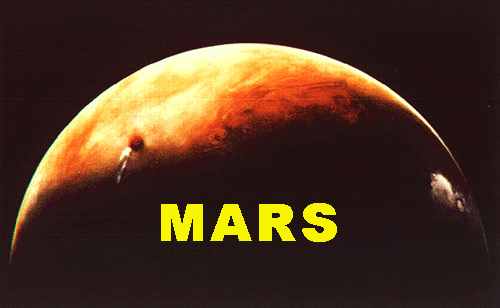
Crescent Mars during Viking 2 approach 1976.
Clouds trail downwind of volcano Ascraeus Mons.
A. Mars: Introduction
Size: A small planet: 50% Diam(Earth); 10% Mass(Earth)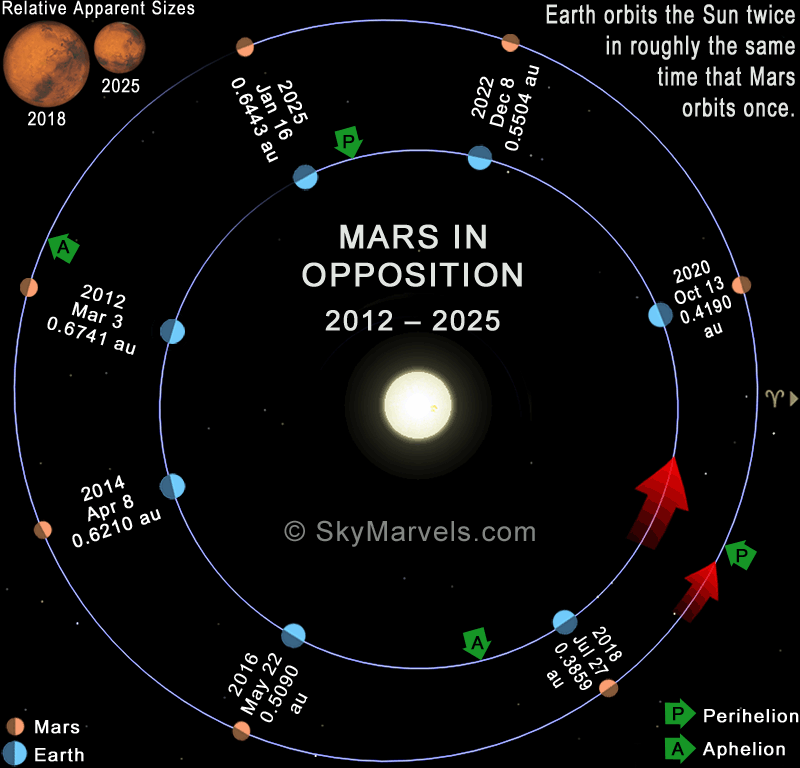 Orbit: Semi-major axis 1.5 AU. Orbital period 1.88 yr.
Orbit: Semi-major axis 1.5 AU. Orbital period 1.88 yr.
-
"Oppositions" occur every 2.1
years
- Mars' distance & brightness at opposition (closest approach to Earth) vary significantly because of its large orbital ellipticity (10%). See the diagram at the right; click for an enlargement.
- When brightest, Mars is a very conspicuous, red-pink object -- hence its association with the God of War. Mars can be brighter than Jupiter.
- Mars' red color is caused by iron oxide compounds such as hematite on its surface. This is equivalent to rust(!). Other conspicuous markings include white polar caps and large dark areas, some appearing greenish to the eye in a telescope.
- Mars is distant enough even at opposition that telescopes on Earth yield relatively poor resolution. This led to a long and controversial history over whether or not there was evidence for "canals" or other artificial features on its surface. (See Section C below.)
- The image below was taken from Earth orbit by the Hubble Space Telescope and shows the main kinds of features visible from Earth.
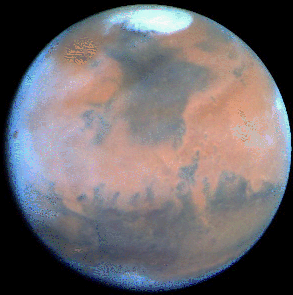
B. Major Spacecraft Missions to Mars
Mars has been the target of over 40 robotic spacecraft missions, many of which, especially the USSR's, failed (wow! incompetence or conspiracy??). Five types have been undertaken: flybys, orbiters, landers, rovers, and one helicopter. Successful missions have mapped nearly its entire surface and have sampled its atmosphere and soil and even subsurface layers using special techniques. Important Earlier Missions:- Mariner Missions: 3 flybys, 1 orbiter, 1964-71; preliminary imaging reconnaissance of Martian surface
- Viking Missions: 2 orbiters/2 landers. 1976. Sampled soil and searched for chemical signatures of lifeforms.
- Mars Pathfinder: a lander with the first rover. Sampled soil and rocks near landing site. 1997.
- Mars Global Surveyor: orbiter. Mapped surface at high resolution with a camera and the MOLA laser altimeter. 1998--2006.
- Mars Exploration Rovers Mission: orbiter plus two landers and rovers ("Spirit" and "Opportunity"), placed on opposite sides of the planet in areas thought to be associated with large water flows in the past. The rovers traveled a combined distance of over 33 miles on Mars' surface. 2004-2018.
- Mars InSight Mission successfully landed on Elysium Planitia in November 2018. InSight was a non-rover mission intended to examine the deep interior of Mars using seismometers. Lost communications with Earth in 2022.
- 2001 Mars Odyssey: orbiter. Studying mineralogy, elemental abundances (including hydrogen, a water tracer). 2001-- .
- Mars Express: first European mission to Mars. Lander failed (2003), orbiter (2004-- ) is studying surface features, mineralogy, atmosphere. Carries a stereoscopic camera and the MARSIS radar instrument for probing subsurface materials.
- Mars Reconnaissance Orbiter: Entered Mars orbit in March 2006. Instrumentation includes the HIRISE camera for high resolution (3 ft on the Martian surface) imaging and experiments for mineral mapping and subsurface analysis by radar.
- The Mars Science Laboratory, successfully landed its "Curiosity" rover in August 2012 in Gale Crater, a large, ancient impact crater which contains an interior mountain of sedimentary deposits.
- The Mars 2020 Mission, which carries a yet more ambitious rover vehicle (Perseverance) in the style of Curiosity, made a successful landing in Jezero Crater on Mars on February 18, 2021. It also carried the first-ever aircraft sent to another planet, the Ingenuity helicopter. Its goal is to survey the sediments of the crater looking for biological markers.
C. Percival Lowell and Canals on Mars
| "What goes on upon all those distant globes? Are they worlds, or are they mere masses of matter? Are physical forces alone at work there, or has evolution begotten something more complex, something not unakin to what we know on Earth as life? It is in this that lies the peculiar interest of Mars." --- Percival Lowell (1895) |
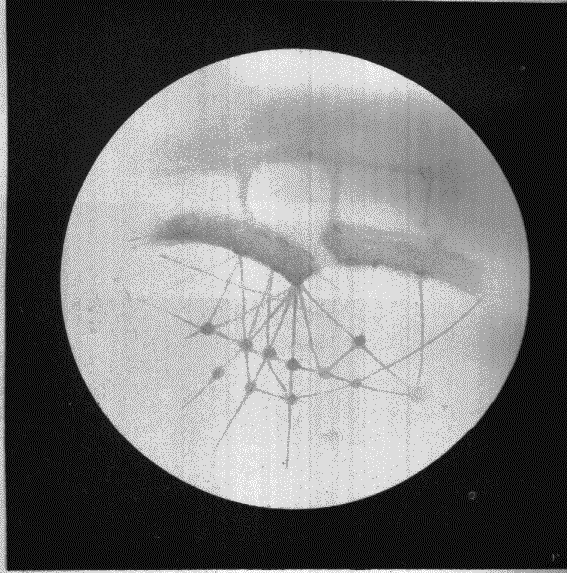
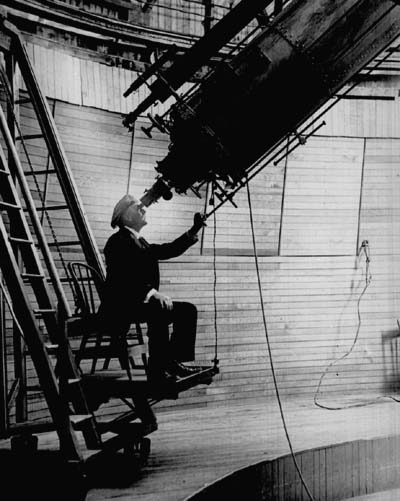 Astronomer Percival
Lowell devoted his career and his observatory (ca. 1890-1915) to
the study of dark features on Mars' surface that he believed to be
artificial canals engineered by an advanced civilization for
survival on a desert planet. He made numerous sketches using a
medium-sized telescope (at left). An example of a Lowell sketch is at
right and shows the long, linear features he called canals. Another, much
more detailed, Lowell map can be
seen here.
Lowell
was not
the only astronomer claiming to have seen the canals. The visibility
of any such features is strongly affected by the blurring effects
("seeing"---see Study Guide 14) of Earth's
atmosphere. The canal enthusiasts claimed to have seen the sharp,
straight-line features crossing the planet's face emerge during brief
moments of atmospheric stability. They believed they saw systematic
changes that implied the Martians were improving their canal system
and greening of the surface indicating vegetation spreading in the
springtime. However, many careful observers were never able to see
the canals at all.
Lowell's efforts to popularize the idea of civilizations on Mars (see
his article proclaiming
"Martians Build Two Immense Canals in Two Years") had a great
impact on the public imagination. They were the stimulus for H.
G. Wells' novel War of the
Worlds, the archetypal story of an alien invasion, and a
tidal wave of subsequent science fiction and fantasy stories
(see Study Guide 18).
Astronomer Percival
Lowell devoted his career and his observatory (ca. 1890-1915) to
the study of dark features on Mars' surface that he believed to be
artificial canals engineered by an advanced civilization for
survival on a desert planet. He made numerous sketches using a
medium-sized telescope (at left). An example of a Lowell sketch is at
right and shows the long, linear features he called canals. Another, much
more detailed, Lowell map can be
seen here.
Lowell
was not
the only astronomer claiming to have seen the canals. The visibility
of any such features is strongly affected by the blurring effects
("seeing"---see Study Guide 14) of Earth's
atmosphere. The canal enthusiasts claimed to have seen the sharp,
straight-line features crossing the planet's face emerge during brief
moments of atmospheric stability. They believed they saw systematic
changes that implied the Martians were improving their canal system
and greening of the surface indicating vegetation spreading in the
springtime. However, many careful observers were never able to see
the canals at all.
Lowell's efforts to popularize the idea of civilizations on Mars (see
his article proclaiming
"Martians Build Two Immense Canals in Two Years") had a great
impact on the public imagination. They were the stimulus for H.
G. Wells' novel War of the
Worlds, the archetypal story of an alien invasion, and a
tidal wave of subsequent science fiction and fantasy stories
(see Study Guide 18).
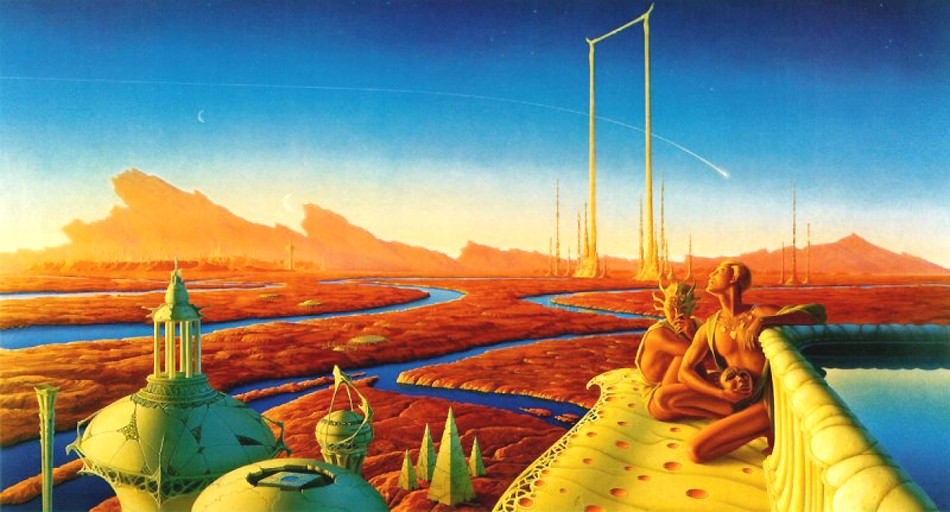
From cover art by Michael Whelan for an edition of "The Martian Chronicles" by Ray Bradbury.

Click for an enlarged comparison of an HST image to classical drawings.
- Beginning in the 1960's, close-up images from spacecraft proved there to be no artificial structures on Mars.
- The claimed "green" markings are likewise an optical illusion, produced by the color contrast between reddish and grey-brown areas.
-
There is a great temptation to overinterpret marginal data and
to try to force them to conform to preconceived ideas. This is a
major factor in many "pseudo-scientific" phenomena (see the discussion
of these in Guide 18.) Good scientists will
resist this. They will honestly assess the uncertainties in the
situation and will withhold judgement until the evidence improves.
-
An example of the best maps of Mars produced by Earth-based telescopes
before the first spacecraft imaging was obtained in the 1960's is
shown here. It bears little
resemblance to modern topographic maps
produced by orbiting spacecraft -- and it also shows no evidence of
the multiple canals claimed by Lowell.
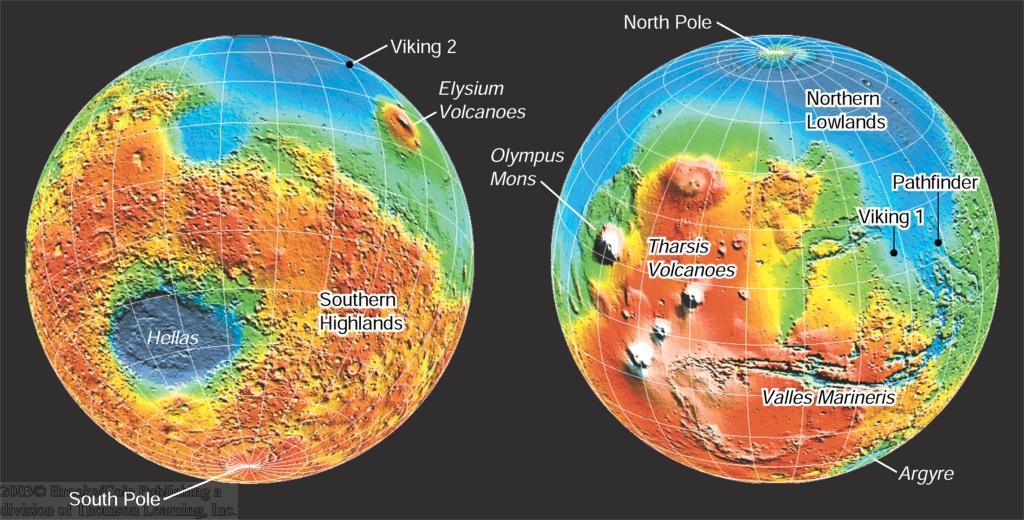
Topographic charts of Mars, color-coded for altitude,
with
main features identified (from the MGS MOLA Altimiter)
D. Martian Topography
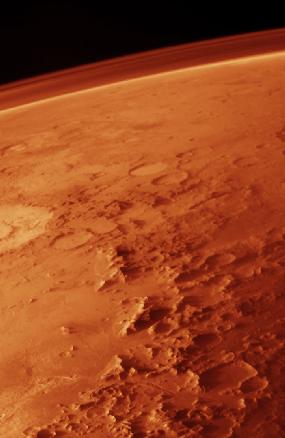 Mars features an amazing landscape. Martian topography has been
surveyed by many spacecraft (see above), now reaching an accuracy
of about one meter.
Mars features an amazing landscape. Martian topography has been
surveyed by many spacecraft (see above), now reaching an accuracy
of about one meter.
 ASTR
1210 Mars Images Page. For illustrations, click here or on
highlighted items below.
ASTR
1210 Mars Images Page. For illustrations, click here or on
highlighted items below.
- The dual-hemisphere image above shows the main topographic features of Mars.
- The image at right illustrates the red color, craters, mountains, plains, and dust-laden atmosphere of Mars. Click for a larger view.
- Impact Craters: are widely distributed with more in the southern hemisphere, which is therefore older. Craters are weathered and often partially dust-filled. The Hellas Basin is the largest impact crater.
- Volcanos: There are 5 large
"shield" volcanos plus a
number of smaller ones.
- First among these, Olympus Mons is the largest mountain in the entire solar system (85,000 ft altitude).
- All the volcanos are dormant now, but there is some evidence for smooth, minor lava flows in the Tharsis region over the past few 100 million years.
- Olympus Mons and the other volcanos in its vicinity are thought to have originated from the upwelling of a warm mantle plume, 3-4 billion years ago
- The plume's effect was concentrated into a huge uplift region (the "Tharsis bulge") because there was minimal motion of the crust past the plume.
- This qualifies as proto-tectonic activity. But Mars' surface is not broken into tectonic plates, and extensive mantle activity has been dormant for most of the last billion years.
- So, neither Mars nor Venus have widespread tectonic plate structures like those on Earth. Mars, however, has not experienced a violent resurfacing episode like that 500 Myr ago on Venus.
- Valles Marineris is the largest canyon in solar system. It was not produced by water (though some "tributary" canyons may have been). Instead, VM is a surface rift, like the African Rift Valley, created by tearing of the rigid surface layers during the Tharsis upwelling.
- Polar caps: the caps in winter are a mixture of frozen CO2 and H2O. They melt and refreeze with seasonal change. Water ice melts at a higher temperature than CO2 ice, so any ice visible between the two melting points must be water ice.
E. Evidence for Water on Mars
 Click for illustrations.
There are no open bodies of water on Mars now, but there is extensive
evidence for the presence of frozen water at the poles and in the soil
and for liquid water on the surface in the past:
Click for illustrations.
There are no open bodies of water on Mars now, but there is extensive
evidence for the presence of frozen water at the poles and in the soil
and for liquid water on the surface in the past:
- Water ice has long been known to be present at the poles. There is a trace of water vapor in the atmosphere [30 times smaller than on Earth, in percentage, but much larger than on Venus]
- By mapping gamma-ray emission, Mars Odyssey (2001+) provided evidence for widespread deposition of (frozen) water molecules in the upper 1-meter of the surface, especially the poles.
- Layered terrain is evidence for sedimentary rocks, deposited by lakes and oceans.
- Erosion channels are evidence of
massive floods at some time in the past.
-
The largest Martian flow channels
are much
larger than on Earth. They imply floods 100-10,000 times the
outflow of the Amazon River at some time in the past.
- Evidence for a huge ocean basin in the northern lowlands.
- Radar evidence for water ice layers buried thousands of feet deep under the Martian poles.
- Lander missions (7 to date, see Study Guide 17) have found extensive evidence for water molecules bound within Martian minerals. The Phoenix lander (2008), with a soil-sampling scoop, detected subsurface ice crystals; its images of changing droplets are possible evidence for liquid (saline) water. Data from the Curiosity lander (2013) indicate that the mean water content of soil minerals on Mars is about 2%, or (if extracted) 2 pints of water per cubic foot of soil.
- All the evidence points to large amounts of liquid water in the past, perhaps one billion years ago. Water ice is widely distributed in the soil and rocks now. It is likely that there are large permafrost reservoirs of water under the surface. In the past, these could have been melted by volcanic activity, inducing widespread, possibly cyclic, floods.
- Independent sources of evidence concerning water are the SNC meteorites (see Guide 17).
Discussion of Mars is continued on Study Guide 17.
Reading for this lecture:
-
Study Guide 16
Bennett textbook, p. 206, Sec. 9.4.
-
Study Guide 17
Bennett textbook, p. 206, Sec. 9.4.
Web Links:
-
The
Planet Mars: A History of Observation and Discovery (by
W. Sheehan)
Text of "Mars And Its Canals" by Percival Lowell
Mars Scientific & Cultural Chronology (Karol & Catling)
Mars in Literature & Film (Catling) The Martians: The True Story of an Alien Craze that Captured Turn-of-the-Century America , (David Baron, 2025). Complete coverage of the remarkable legacy of Percival Lowell. Selected Mars Images For ASTR 1210 (O'Connell)
3D Viewing of Mars on Google Earth Overview of Spacecraft Exploration of Mars (Wikipedia) Mars Info at Views of the Solar System
Mars Info at The Nine Planets
Mars Geology (Remote Sensing Tutorial)
MarsoWeb (NASA) Water on Mars (Wikipedia article) Mars Missions:
 Previous Guide
Previous Guide
|
 Guide Index
Guide Index
|
 Next Guide
Next Guide
|
 Click here to see a global Mars video composited from multiple
HST data frames.
Click here to see a global Mars video composited from multiple
HST data frames.